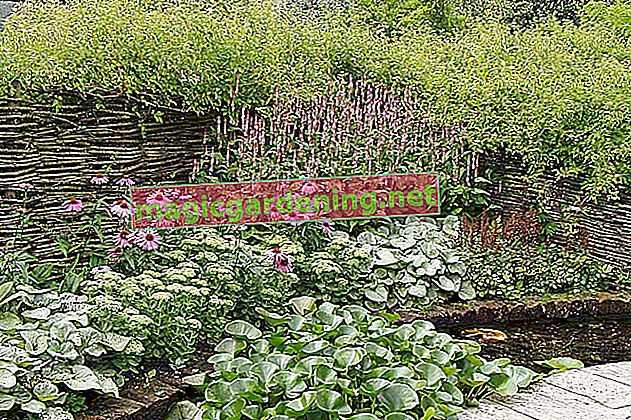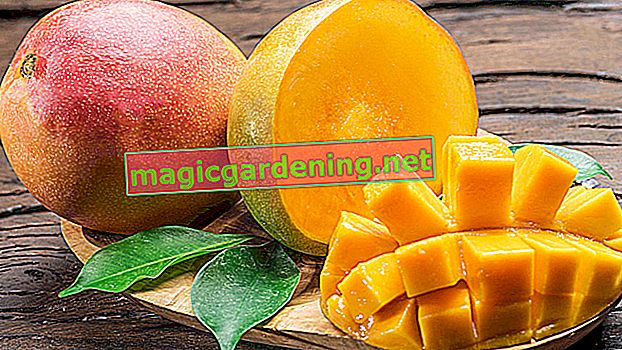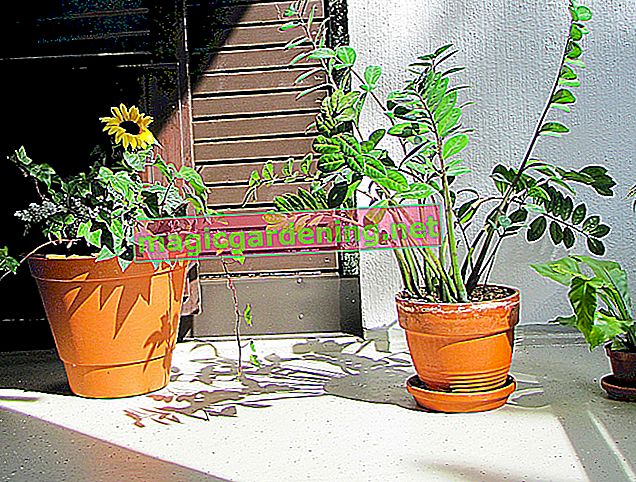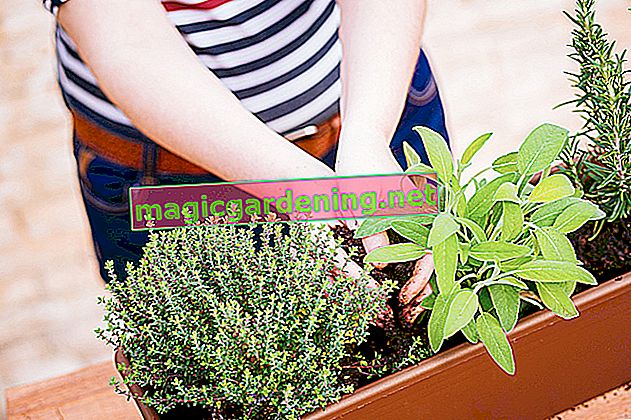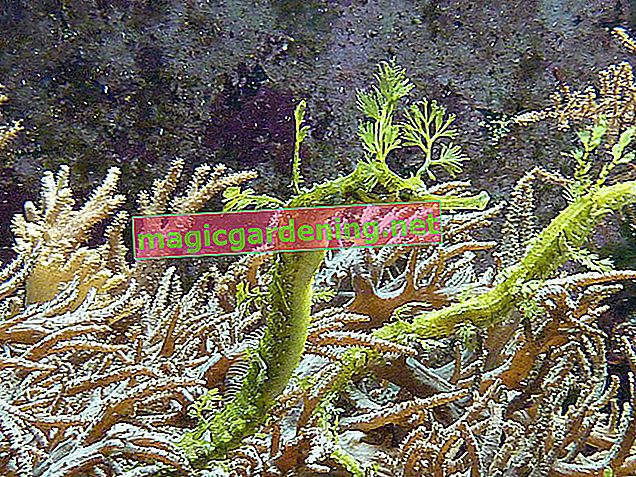
the essentials in brief
- The caterpillars of the vegetable owl are a pest that likes to eat vegetables
- The insects are up to 4.5cm long, bright green, brown, gray or pink and have broad yellowish or white lines on the sides
- Vegetable owl caterpillars especially like to eat tomatoes, lettuce, peas, cabbage, but also fruit such as currants, ornamental flowers such as cyclamen and even nettles
- Predatory bugs, Bacillus thuringiensis, and neem oil are effective agents against vegetable owls
Recognize vegetable owls
Children love the vegetable owl, while hobby gardeners tend to fear them. The vegetable owl is an insect whose caterpillars prefer to eat tomatoes in the greenhouse. It is not uncommon for pitting corrosion to occur in leaves and fruits show traces and legacies. In the event of superficial damage, you can still process peppers and tomatoes. Thoroughly wash off traces of manure and remove damaged areas. In the owl made of vegetables, damaged vegetable fruits are no longer noticeable and the children like the colorful creation with dip best.
also read
- Repotting the phoenix palm - interesting tips and tricks
- Four interesting balsam species
- Interesting facts about acacia leaves
| Main flight time | particularities | |
|---|---|---|
| Vegetable owl | May to June | ring- and kidney-shaped spots |
| Mutable herb owl | April to June, July to September | clear wavy line, extends into the wing fringes |
| Pea owl | May to August | indistinct W-markings, noticeable v-spot |
features

Vegetable owls are among the moths that are widespread in Europe and can be observed twice a year if the weather conditions are ideal. They first appear between mid-May and late July. The next generation flies from early August to mid-September. Their wingspan is about four centimeters. The front wings of adult moths are brown-red in color, while the hind wings have a light reddish basic color. There are different color variations. Occasionally, specimens with yellow-red or black-brown forewings can be observed.
Samples and drawings:
- indistinct transverse lines, some of which are missing
- gray and reddish lines, ring- or kidney-shaped
- white W drawing
development
Females lay their green colored eggs on suitable forage plants. The caterpillars hatch after about a week. The caterpillars molt five to six times between September and October. After 30 to 40 days, they pupate underground in a dark reddish-brown cocoon in which the caterpillars overwinter. These caterpillars represent the first generation. Second generation caterpillars develop between August and September.

Caterpillars
The voracious offspring are nocturnal like the adult moths and hide at the base of their forage plants during the day. This makes the plant pests difficult to detect. Occasionally, the caterpillars can be observed in an elongated position on the leaves during the day.
Recognize caterpillars:
- Length up to 45 millimeters
- variable body color: green, brown, gray or pink
- fine white spots
- broad, pale yellow to white line
- yellowish to greenish brown head
Forage plants of the vegetable owl
The butterfly likes to come to light and can be observed on different flowers. Favorite nectar donors include the Canadian goldenrod, bindweed, common water dost, or butterfly lilac. The caterpillars feed on plant tissue. They don't specialize in any type of food and eat both leaves and fruits. They often appear on tomatoes, peppers and lettuce.
Forage plants of the caterpillars:
- Vegetables : cabbage, peas
- Fruit bushes: currant, sloe
- Ornamental plants : cyclamen, common heather, toadflax
- Weeds : dock, nettle
Fight the vegetable owl
The caterpillars of the vegetable owl cause great damage both in commercial vegetable growing and in private gardens. As a field pest, the species is of little importance because of the use of insecticides. In your own vegetable gardening, you should avoid chemical agents and fight the pests biologically.
Control of caterpillars with nematodes
Roundworms are suitable for combating pests that prefer to live in the ground and feed on plant roots. Therefore they do not develop their full effect on the caterpillars of the vegetable owl. They can still be used to reduce the population density. If the caterpillars attack root vegetables such as carrots, nematodes of the species Steinernema carpocapsae can be a useful measure.
Destroy butterflies with a pheromone trap
The traps attract male moths with species-specific sex hormones. When attempting to land, these stick to the glued surface and can no longer escape. Although the males are prevented from mating by this measure, a strong infestation by the vegetable owl cannot be eliminated with any pheromone trap. Such products are suitable for control and should only be used in the greenhouse.
Natural enemies

Predatory bugs are active hunters that lie in wait for flowers or crawl through vegetation and grab various prey. Live insects can be bought in specialist shops. Bring predatory bugs and larvae to various points in the greenhouse so that the beneficial insects can immediately go hunting. Storage is possible, but should be avoided. The longer you wait before spreading, the more predatory bugs can die from a lack of food.
Correct storage:
- no longer than a day or two
- at temperatures between eight and ten degrees Celsius
- in the dark
Digression
This is how predatory bugs hunt
The insects do not specialize in any particular prey. They prey on arthropods and insects, which can also be considerably larger than themselves. Predatory bugs and their nymphs hold prey with their strong and sometimes hairy catch legs. They stick their long proboscis into the prey to inject saliva. This paralyzes the prey and decomposes the internal organs. Predatory bugs only have to suck out the juice.Neem oil
The oil from the neem tree contains azadirachtin, which has an insecticidal effect. It is often advised that a few drops of neem oil can be added to the irrigation water. The plants should absorb the ingredients and transport them into the leaves. These taste bitter, so the caterpillars look for other forage plants. Nothing is known about the effects of this method.
However, neem oil is used successfully as a contact insecticide. If you spray the affected plants with a low-dose solution of water and oil, a lethal effect develops. Note, however, that products containing neem oil extract are legally recognized as insecticides, and certain regulations apply to their use in private gardens. The ingredient does not work selectively and also harms beneficial insects.
Products containing neem oil extracts are considered insecticides by law and should be used as directed.
Bacillus thuringiensis
The bacterium occurs naturally in the soil and often lives in company with plant roots. It produces certain toxic substances that are fatal to some insects. These toxins are used to fight harmful beetles, skin and two-winged birds or butterflies. The substances are ineffective in plants and vertebrates.
This is how the bacterium works:
- secrete proteins that attach to intestinal cells
- these create pores in the cell wall
- The intestinal cell is destroyed and the organism dies
Tips
There are different products for spraying. Please note the information in the package insert, because such agents are only approved for certain areas of application and plants.
Prevent
To prevent pests from spreading, you should protect your plants from the voracious caterpillars. Mixed cultures generally help to keep pests at bay naturally. There are enough beneficial insects here and many plants give off repulsive smells.
Borago officinalis

Borage is a plant from the predatory leaf family, which is used in the kitchen as a spice or vegetable. Its blue flowers are rich in nectar and attract honey bees. The scent is said to have a deterrent effect on vegetable owls, so that female butterflies are prevented from laying eggs. Put some plants between your tomatoes and watch the butterflies behave.
Safety nets
So that the moths are efficiently prevented from laying eggs, you should put protective nets over their vegetables. Check your plants regularly for pests. Caterpillars can be picked up by hand and placed on another forage plant in nature.
Tips
Chickens are efficient pest killers. They scratch the ground and peck the resting caterpillars.
frequently asked Questions
How common are vegetable owls?
The natural habitats of the vegetable owl include floodplains, swamp forests and valley floors. However, it is a cultural follower and is widespread in Europe. The moths mainly populate cultivated landscapes such as parks, gardens or fallow land with suitable forage plants. They do not specialize in any particular plants, but rather feed on species from different genera. The caterpillars can often be seen on tomatoes and peppers.
How do I recognize an infestation by the vegetable owl?
The caterpillars feed on the soft leaf tissue. They leave traces of food in the leaves and occasionally attack the fruits or roots of vegetable plants. During the day, the caterpillars hide at the base of the stem or bask in the sun on a leaf. They are difficult to spot because of their green color. When touched, they curl up.
What can I do against an infestation by vegetable owls?
Protect your plants with close-meshed nets so that the female moths can no longer lay their eggs. If you find caterpillars, collect them and place them on an alternative forage crop such as the nettle. Products with neem extracts should be used cautiously as they are not selective. Predatory bugs and nematodes or special bacteria can support control measures.
How to make an owl from vegetables
Tomatoes form the body of the owl, which is stuffed with cucumber slices. Paprika strips these as wings and beak. Mix the cream cheese with garlic and mint and pour the dip into two containers of the same size. With an olive in the middle, the bowls act as eyes



